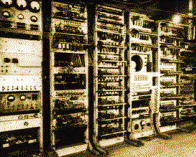| |

|
Overview
|
|
This article explains how to use the Resource Compiler (RC.EXE) to create
resource files (.RES).
- About the Resource Compiler
- String Resources
- Binary Resources
- RC.EXE Options
|
|
About the Resource Compiler (RC.EXE)
|
|
The Resource Compiler compiles the resource definition file and the resource
files (binary files such as icon, bitmap, and cursor files) into a binary
resource (.RES) file. The .RES file can then be included in any VB project,
and once the VB project is compiled, the resources are accessible to Win32 API
functions as well as the standard VB LoadResString, LoadResPicture
and LoadResData functions.
The Resource Compiler itself consists of two files:
- RC.EXE
- RCDLL.DLL
These files come in the \Tools directory of Enterprise Editions of VB; if you don't have
that then you can download the files by downloading the VB5 Resource Add-In from the
Visual Basic Owner's Area at MSDN.
Resources can be divided into two groups:
- String resources (text strings such as "vbAccelerator").
- Binary resources (icons, bitmaps, cursors, sounds, video, and so forth).
|
|
2. String Resources
|
|
String resources are stored in a string table in the resource definition
file.
Syntax
STRINGTABLE [load-option] [mem-option]
BEGIN
stringID string
.
.
.
END
The STRINGTABLE statement defines one or more string resources for an
application. String resources are simply null-terminated ASCII strings that
can be loaded when needed from the executable file, using the LoadResString
function.
Parameters
-
load-option. Specifies when the resource is to be loaded. This optional
parameter must be one of the following options:
- PRELOAD
Resource is loaded immediately.
- LOADONCALL
(Default) Resource is loaded when called.
-
mem-option. Specifies whether the resource is fixed or can be moved
and whether or not can be discarded. This optional parameter can
be one of the following options:
- FIXED
Resource remains at a fixed memory location.
- MOVEABLE
Resource can be moved if necessary in order to compact
memory.
- DISCARDABLE
Resource can be discarded if no longer needed.
-
stringID. Specifies an integer value that identifies the resource.
-
string. Specifies one or more ASCII strings, enclosed in double quotation
marks. The string must be no longer than 255 characters and must occupy a
single line in the source file.
Grouping strings in separate segments allows all related strings to be read
once in a single reading and discarded together. When possible, you should
be able to move and discard the table. The Resource Compiler allocates
16 strings per segment and uses the identifier value to determine which
segment will contain the string. Strings with the same upper-12 bits in
their identifiers are placed in the same segment.
Example
The following example demonstrates the STRINGTABLE statement:
#define IDS_HELLO 1
#define IDS_GOODBYE 2
STRINGTABLE
BEGIN
IDS_HELLO, "Hello"
IDS_GOODBYE, "Goodbye"
END
|
|
3. Binary Resources
|
|
Binary resources are not stored in the resource definition file. The
resource definition file includes only a pointer to the files containing
the binary resources, for example, icon (.ICO), bitmap (.BMP), cursor (.CUR),
sound (.WAV), and video (.AVI) files.
This pointer is called a Single-Line Statement in the resource definition
file.
Syntax
nameID keyword [load-option] [mem-option] filename
Parameters
-
nameID. Specifies either a name or an integer value identifying the
resource. This ID has to be unique for every category specified by the
keyword. In the category ICON the ID 0 is reserved for the Visual Basic
icon. Therefore you'll have to start ID for ICONS at 1.
-
keyword. Specifies the type of file. The parameter must be one of the
following options:
- BITMAP
Defines a bitmap (.BMP)
- CURSOR
Defines a cursor (.CUR)
- ICON
Defines an icon (.ICO)
- SOUND
Defines a wave file (.WAV)
- VIDEO
Defines a video file (.AVI)
-
load-option. Specifies when the resource is to be loaded. The parameter
must be one of the following options:
- PRELOAD>
Resource is loaded immediately.
- LOADONCALL
(Default) Resource is loaded when called.
-
mem-option. Specifies whether the resource is fixed or can be moved and
whether it can be discarded. The parameter must be one of the following
options:
- FIXED
Resource remains at a fixed memory location.
- MOVEABLE
Resource can be moved if necessary in order to compact
memory.
- DISCARDABLE
Resource can be discarded if no longer needed.
The default for binary resources is MOVEABLE.
-
filename. Specifies the name of the file that contains the resource.
The name must be a valid filename; it must be a full path
if the file is not in the current working directory. The path can
be either a quoted or non-quoted string.
Example
The following example specifies two bitmap resources:
disk1 BITMAP disk.bmp
12 BITMAP PRELOAD diskette.bmp
|
|
4. RC.EXE Options
|
|
To start the Resource Compiler, use the rc command.
Syntax
rc /r [options] definition-file
Parameters
-
/r
This parameter specifies that the .RC file will only be
compiled, not linked to any executable (required for use with VB)
-
options
You can use the following options with the rc command:
- /?
Displays a list of rc command-line options.
- /fo newname
Uses newname for the name of the .RES file.
-
definition-file
The definition-file parameter specifies the name of
the resource definition file (.RC) that contains the names, types,
filenames, and descriptions of the resources to be compiled.
Example
RC /r /fo TEST32.RES TEST.RC
Note:
You have to close your Visual Basic project or remove the .RES file from your
project when you recreate the resource file.
|
|
 Back to top Back to top
 Back to Articles Back to Articles
|
|


